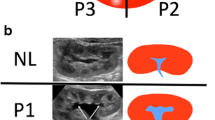Abstract
In 2014, a multidisciplinary consensus on the classification of pre- and postnatal urinary tract dilation (UTD classification) was developed. Its goal was to provide a standardized system for evaluating and reporting urinary tract dilation both in the prenatal and postnatal periods. In this review, we summarize insights learned from the implementation of the UTD classification system since its inception, providing clarifications on common points of confusion. In addition, we review current literature in the clinical validation of the UTD classification system to provide credence for its use in managing fetuses and children with urinary tract dilation.












Similar content being viewed by others
References
Nguyen HT, Benson CB, Bromley B et al (2014) Multidisciplinary consensus on the classification of prenatal and postnatal urinary tract dilation (UTD classification system). J Pediatr Urol 10:982–998
Chow JS, Koning JL, Back SJ et al (2017) Classification of pediatric urinary tract dilation: the new language. Pediatr Radiol 47:1109–1115
Calle-Toro JS, Maya CL, Gorfu Y et al (2020) Supine versus prone positioning for ultrasound evaluation of postnatal urinary tract dilation in children. Pediatr Radiol 50:357–362
Back SJ, Christopher Edgar J, Weiss DA et al (2018) Rater reliability of postnatal urinary tract dilation consensus classification. Pediatr Radiol 48:1606–1611
Kenney IJ, Negus AS, Miller FN (2002) Is sonographically demonstrated mild distal ureteric dilatation predictive of vesicoureteric reflux as seen on micturating cystourethrography? Pediatr Radiol 32:175–178
Vivier PH, Augdal TA, Avni FE et al (2018) Standardization of pediatric uroradiological terms: a multidisciplinary European glossary. Pediatr Radiol 48:291–303
Zelenko N, Coll D, Rosenfeld AT, Smith RC (2004) Normal ureter size on unenhanced helical CT. AJR Am J Roentgenol 182:1039–1041
Chitty LS, Altman DG (2003) Charts of fetal size: kidney and renal pelvis measurements. Prenat Diagn 23:891–897
Odibo AO, Raab E, Elovitz M et al (2004) Prenatal mild pyelectasis: evaluating the thresholds of renal pelvic diameter associated with normal postnatal renal function. J Ultrasound Med 23:513–517
van Vuuren SH, Damen-Elias HA, Stigter RH et al (2012) Size and volume charts of fetal kidney, renal pelvis and adrenal gland. Ultrasound Obstet Gynecol 40:659–664
Schaeffer AJ, Kurtz MP, Logvinenko T et al (2016) MRI-based reference range for the renal pelvis anterior-posterior diameter in children ages 0–19 years. Br J Radiol 89:20160211
Nelson CP, Lee RS, Trout AT et al (2019) The association of postnatal urinary tract dilation risk score with clinical outcomes. J Pediatr Urol 15:341.e1–e6
Swenson DW, Darge K, Ziniel SI, Chow JS (2015) Characterizing upper urinary tract dilation on ultrasound: a survey of North American pediatric radiologists’ practices. Pediatr Radiol 45:686–694
Bratina P, Kersnik Levart T (2020) Clinical outcome is associated with the urinary tract dilatation classification system grade. Croat Med J 61:246–251
Zhang H, Zhang L, Guo N (2020) Validation of "urinary tract dilation" classification system: correlation between fetal hydronephrosis and postnatal urological abnormalities. Medicine 99:e18707
Kaspar CDW, Lo M, Bunchman TE, Xiao N (2017) The antenatal urinary tract dilation classification system accurately predicts severity of kidney and urinary tract abnormalities. J Pediatr Urol 13:485.e1–e7
Hodhod A, Capolicchio JP, Jednak R et al (2016) Evaluation of urinary tract dilation classification system for grading postnatal hydronephrosis. J Urol 195:725–730
Cakici EK, Aydog O, Eroglu FK et al (2019) Value of renal pelvic diameter and urinary tract dilation classification in the prediction of urinary tract anomaly. Pediatr Int 61:271–277
Braga LH, McGrath M, Farrokhyar F et al (2018) Society for Fetal Urology classification vs. urinary tract dilation grading system for prognostication in prenatal hydronephrosis: a time to resolution analysis. J Urol 199:1615–1621
Agard H, Massanyi E, Albertson M et al (2020) The different elements of the urinary tract dilation (UTD) classification system and their capacity to predict findings on mercaptoacetyltriglycine (MAG3) diuretic renography. J Pediatr Urol 16:686.e1-e6
Lee RS, Cendron M, Kinnamon DD, Nguyen HT (2006) Antenatal hydronephrosis as a predictor of postnatal outcome: a meta-analysis. Pediatrics 118:586–593
Chalmers DJ, Meyers ML, Brodie KE et al (2016) Inter-rater reliability of the APD, SFU and UTD grading systems in fetal sonography and MRI. J Pediatr Urol 12:305.e1–e5
Nelson CP, Heller HT, Benson CB et al (2020) Interobserver reliability of the antenatal consensus classification system for urinary tract dilatation. J Ultrasound Med 39:551–557
Rickard M, Easterbrook B, Kim S et al (2017) Six of one, half a dozen of the other: a measure of multidisciplinary inter/intra-rater reliability of the Society for Fetal Urology and urinary tract dilation grading systems for hydronephrosis. J Pediatr Urol 13:80.e1–e5
Gray MC, Zillioux JM, Varda B et al (2020) Assessment of urinary tract dilation grading amongst pediatric urologists. J Pediatr Urol 16:457.e1–e6
Suson KD, Preece J (2020) Do current scientific reports of hydronephrosis make the grade? J Pediatr Urol 16:597.e1–e6
Maizels M, Braga L, Gong EM et al (2017) “1 voice”: learn urinary tract dilation (UTD) classification to assess fetal & newborn urological ultrasound findings. J Pediatr Urol 13:559–562
Author information
Authors and Affiliations
Corresponding author
Ethics declarations
Conflicts of interest
None
Additional information
Publisher's note
Springer Nature remains neutral with regard to jurisdictional claims in published maps and institutional affiliations.
Rights and permissions
About this article
Cite this article
Nguyen, H.T., Phelps, A., Coley, B. et al. 2021 update on the urinary tract dilation (UTD) classification system: clarifications, review of the literature, and practical suggestions. Pediatr Radiol 52, 740–751 (2022). https://doi.org/10.1007/s00247-021-05263-w
Received:
Revised:
Accepted:
Published:
Issue Date:
DOI: https://doi.org/10.1007/s00247-021-05263-w




